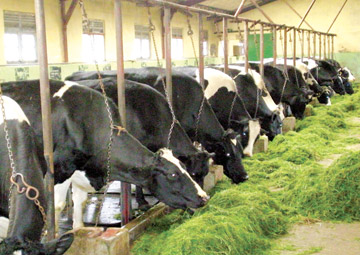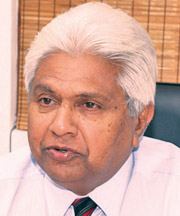|
Livestock Development Ministry, Milco target
self-sufficiency:
Five-year plan to boost milk production
L.S. Ananda Wedaarachchi
 Sri Lanka imports milk powder worth over Rs. 36 billion annually. The
Livestock Development Ministry together with Milco (Pvt) Ltd., will
cater to the country’s milk food requirements under the five-year
development plan, said Chairman Milco, Sunil Wickramasinghe. Sri Lanka imports milk powder worth over Rs. 36 billion annually. The
Livestock Development Ministry together with Milco (Pvt) Ltd., will
cater to the country’s milk food requirements under the five-year
development plan, said Chairman Milco, Sunil Wickramasinghe.
Wickramasinghe who is an expert in the milk industry with an
experience of over 28 years in a private sector milk company said that
the country could achieve self-sufficiency in liquid milk through a
systematic development strategy. In an interview with the Sunday
Observer he said that the government took a bold decision to increase
the liquid milk price to encourage local milk farmers last week.
Excerpts of the interview:
Q: Sri Lanka has all resources to be self-sufficient in liquid
milk and the Mahinda Chinthanaya targets to achieve it before 2015. What
are the steps taken by the Ministry of Livestock Development and Milco
Ltd., to realise these objectives?
A: Milco (Pvt) Ltd., has implemented a five-year plan to
improve fresh milk production and dried milk powder production Under the
guidance of Livestock Development and Rural Community Development
Minister Arumugam Thondaman. It will also create public awareness on the
importance of liquid milk for nutrition and good health.

Arumugam Thondaman |

Sunil Wickramasinghe |
Q: This matter was discussed during the past couple of decades
but nothing was achieved. What has really gone wrong?
A: A practical strategy should have been implemented to
achieve the desired targets. Producing, processing and sale of milk
should go hand-in-hand to ensure self-sufficiency in liquid milk.
Q: Could you elaborate on this?
A: India, Australia, New Zealand and Denmark became
self-sufficient in milk through systematic planing.
The milk farmer who supplies freshmilk plays a pivotal role in any
blueprint for self-sufficiency in milk.
India organise milk farmers cooperative societies in 1950s and
encouraged them to practise advanced scientific methods to improve milk
production.
Milco also encouraged milk farmers to organise themselves under milk
producer’s societies during the last few years. There are over 1,000
such societies in the milk producing areas.
Q: The five-year development plan proposes to set up six mega
farms in the Island. Could you elaborate?
A: The milk industry is a very delicate industry. The
nutrition value of milk ceases after around five hours. Collecting,
chilling and processing of milk should be done is a scientific manner.
The small-scale milk farmer does not have such facilities or
scientific know-how. The State-owned Milco company and leading private
sector companies have at present monopolized the milk industry. Sri
Lanka produces only 12 percent of the country’s milk requirements.
The government has selected six internationally reputed companies to
set up mega milk farms in milk processing areas. Each farm which will
have over 4,000 cows will produce at least 40,000 litres of milk per day
under the mega farm scheme. The six farms will produce a total of
240,000 litres of milk per day.
Q: Will there be a close liason between these mega farms and
the small-scale milk farmers?
A: Exactly so, it is the aim of this strategy. One of the
conditions of the agreement with these foreign investors is that they
must assist milk farmers who live within a radius of 50 kilometres of a
mega farm. All these mega farms run on international standards. Public
and private sector linkage will boost the milk industry as it happened
in India and Europe.
Q: While the local cows give only a few litres of milk the
foreign stock will provide over 20 litres. Are there plans to increase
yield from the local cows?
A: This is an area to be addressed soon. Under the mega farm
scheme milk villages will be set up around the farms.
The mega farms will conduct training programs to provide technical
and scientific knowledge to village level milk farmers to improve their
skills.
An animal food producing factory will be set up in the mega farm to
ensure quality food for the village cows.
Q: Have you identified areas to set up six proposed mega
farms?
A: Yes, They will be set up close to the farms run by National
Livestock Development Board from Hambantota to Jaffna.
Q: How do you explain the corporate responsibility of your
company?
A: We have a special program to encourage breast feeding.
“Breast milk is the Best” is the theme of that program. Our aim is to
increase the nutrition levels of the nation.
We have implemented a number of programs such as “milk for
schoolchildren and hospitals” and also to encourage liquid milk
consumption and increase the number of “House for Taste and Nutrition”
sales outlets.
Q: What are the observations on your staff and the present
range of products?
A: The brand name “Highland” and the Milco human resource
sector are most precious to the company. The Milco resource sector is
geared to produce and market high quality ‘Highland’ milk and other milk
based Milco products.
Freshness and quality which confirm to international standards are
the salient features of our products.
Only ‘Highland’ milk powder is processed and marketed within few days
from the fresh milk stage. Milco milk products such as yoghurt, curd,
butter, ice cream and sterilized milk are factory fresh products.
My aim is to transfer Milco into one of the leading ventures and also
create job satisfaction among the Milco employees. |

